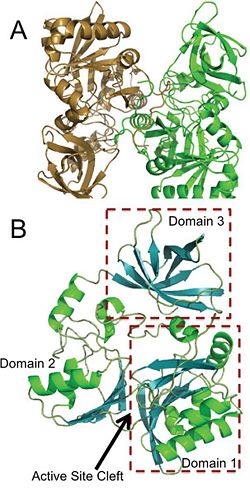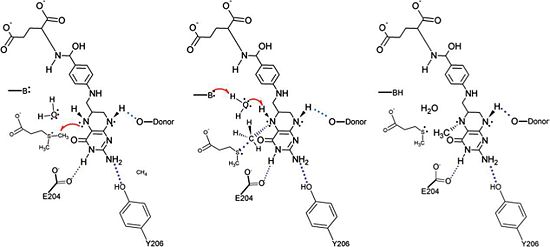Aminomethyltransferase
From Proteopedia
(Difference between revisions)
m (Dimethylsulfoniopropionate-Dependent Demethylase (DmdA) moved to Aminomethyltransferase: requested by Editor) |
|||
| (6 intermediate revisions not shown.) | |||
| Line 1: | Line 1: | ||
| + | <StructureSection load='3tfh' size='350' side='right' scene='' caption='Dimethylsulfoniopropionate-dependent demethylase (DmdA) complex with glycerol and sodium ion, [[3tfh]]'> | ||
== Function == | == Function == | ||
| Line 4: | Line 5: | ||
=Dimethylsulfoniopropionate-Dependent Demethylase (DmdA) or AMT-like protein= | =Dimethylsulfoniopropionate-Dependent Demethylase (DmdA) or AMT-like protein= | ||
| - | <Structure load='3TFH' size='400' frame='true' align='right' caption='Dimethylsulfoniopropionate-Dependent Demethylase (DmdA) complex with glycerol and sodium ion, [[3tfh]]' scene='Insert optional scene name here' /> | ||
==Introduction== | ==Introduction== | ||
| Line 14: | Line 14: | ||
[[Image:Domains+ActiveSite.jpg|thumb|250px|left|Panel A is an image of the protein dimer DmdA. Panel B contains the three labeled domains and the active cleft site of DmdA. This image was obtained directly from Schuller et al. and is reproduced with permission of John Wiley & Sons, Inc.]] | [[Image:Domains+ActiveSite.jpg|thumb|250px|left|Panel A is an image of the protein dimer DmdA. Panel B contains the three labeled domains and the active cleft site of DmdA. This image was obtained directly from Schuller et al. and is reproduced with permission of John Wiley & Sons, Inc.]] | ||
| - | + | {{Clear}} | |
The structure of DmdA has recently been solved through the use of X-Ray diffraction <ref> Image from the RCSB PDB (www.pdb.org) of PDB ID 3TFH (Schuller, D.J., Reisch, C.R., Moran, M.A., Whitman, W.B., Lanzilotta, W.N. (2012) Structures of dimethylsulfoniopropinate-dependent demethylase from the marine organism pelagabacter ubique. Protein Sci. 21: 289-298). </ref>. The structure is a protein dimer composed of 369 amino acid residues and contains three distinct domains and four <scene name='Sandbox_Reserved_497/Ligand/1'>ligands</scene>, two of which are sodium ions and two of which are glycerol. The structure is composed of both <scene name='Sandbox_Reserved_497/Helix/1'>alpha-helices</scene> and <scene name='Sandbox_Reserved_497/Sheets/1'>beta-sheets</scene> and has <scene name='Sandbox_Reserved_497/Hydrophobic/1'>hydrophobic</scene> regions dispersed throughout the protein, though the active site cleft is highly accessible by water. The active site cleft is located between domain 1 and domain 2. Each domain contains unique identifying structural components. <scene name='Sandbox_Reserved_497/Domain1/1'>Domain 1</scene> is characterized by a Greek Key surrounded by three alpha-helices while <scene name='Sandbox_Reserved_497/Domain2/1'>domain 2</scene> contains a five-stranded antiparallel beta-sheet with alpha-helices on either side. Alternatively, <scene name='Sandbox_Reserved_497/Domain3/1'>domain 3</scene> has a distorted jellyroll formation. While DmdA belongs to the glycine cleavage T-protein (GcvT) family there is only approximately <scene name='Sandbox_Reserved_497/Conserved/1'>25% sequence identity</scene>. These few conserved amino acids likely interact with THF, which is a cofactor required by DmdA as well as many other enzymes in the GcvT family. While the exact binding mechanism of THF to the active site cleft of DmdA is still unknown, it appears as if the mechanism is unlike the general mechanism used by enzymes in the GcvT family and is unique to DmdA. In particular, amino acid residues <scene name='Sandbox_Reserved_497/Thf/1'>95, 177, 178, 204, and 206</scene> may be essential for THF binding as they assist in ring stacking as well as have the potential for hydrogen bonding. Similarly, research is still being conducted in order to determine the amino acids essential for the binding of the substrate, DMSP, to DmdA. So far it appears as if amino acid residues <scene name='Sandbox_Reserved_497/Dmsp/1'>11, 32, 197, and 246</scene> are important due to their potential for hydrogen bonding. | The structure of DmdA has recently been solved through the use of X-Ray diffraction <ref> Image from the RCSB PDB (www.pdb.org) of PDB ID 3TFH (Schuller, D.J., Reisch, C.R., Moran, M.A., Whitman, W.B., Lanzilotta, W.N. (2012) Structures of dimethylsulfoniopropinate-dependent demethylase from the marine organism pelagabacter ubique. Protein Sci. 21: 289-298). </ref>. The structure is a protein dimer composed of 369 amino acid residues and contains three distinct domains and four <scene name='Sandbox_Reserved_497/Ligand/1'>ligands</scene>, two of which are sodium ions and two of which are glycerol. The structure is composed of both <scene name='Sandbox_Reserved_497/Helix/1'>alpha-helices</scene> and <scene name='Sandbox_Reserved_497/Sheets/1'>beta-sheets</scene> and has <scene name='Sandbox_Reserved_497/Hydrophobic/1'>hydrophobic</scene> regions dispersed throughout the protein, though the active site cleft is highly accessible by water. The active site cleft is located between domain 1 and domain 2. Each domain contains unique identifying structural components. <scene name='Sandbox_Reserved_497/Domain1/1'>Domain 1</scene> is characterized by a Greek Key surrounded by three alpha-helices while <scene name='Sandbox_Reserved_497/Domain2/1'>domain 2</scene> contains a five-stranded antiparallel beta-sheet with alpha-helices on either side. Alternatively, <scene name='Sandbox_Reserved_497/Domain3/1'>domain 3</scene> has a distorted jellyroll formation. While DmdA belongs to the glycine cleavage T-protein (GcvT) family there is only approximately <scene name='Sandbox_Reserved_497/Conserved/1'>25% sequence identity</scene>. These few conserved amino acids likely interact with THF, which is a cofactor required by DmdA as well as many other enzymes in the GcvT family. While the exact binding mechanism of THF to the active site cleft of DmdA is still unknown, it appears as if the mechanism is unlike the general mechanism used by enzymes in the GcvT family and is unique to DmdA. In particular, amino acid residues <scene name='Sandbox_Reserved_497/Thf/1'>95, 177, 178, 204, and 206</scene> may be essential for THF binding as they assist in ring stacking as well as have the potential for hydrogen bonding. Similarly, research is still being conducted in order to determine the amino acids essential for the binding of the substrate, DMSP, to DmdA. So far it appears as if amino acid residues <scene name='Sandbox_Reserved_497/Dmsp/1'>11, 32, 197, and 246</scene> are important due to their potential for hydrogen bonding. | ||
| Line 23: | Line 23: | ||
[[Image:DmdA_Mechanism.jpg|thumb|550px|right|The proposed mechanism for the methyl transfer reaction catalyzed by DmdA. This image was obtained directly from Schuller et al. and is reproduced with permission of John Wiley & Sons, Inc.]] | [[Image:DmdA_Mechanism.jpg|thumb|550px|right|The proposed mechanism for the methyl transfer reaction catalyzed by DmdA. This image was obtained directly from Schuller et al. and is reproduced with permission of John Wiley & Sons, Inc.]] | ||
| - | + | {{Clear}} | |
==Possible Applications== | ==Possible Applications== | ||
DMSP and its degradation products, particularly dimethyl sulfide (DMS), play a key role in the sulfur cycle. Therefore a complete understanding of both the cleavage and demethylation pathways as well as the enzymes involved could have significant environmental implications. In particular, it currently appears that certain types of organisms such as ''Pelagabacter ubique,'' the microbe that DmdA was originally isolated from, utilize the demethylation pathway over the cleavage pathway because it provides an additional carbon energy source. The ability to not only identify the organisms that degrade DMSP, but also the conditions under which each pathway is more favorable, could have significant biogeochemical and bioremediation applications. However, there is a significant amount of research that must be conducted before those applications can even begin to be considered. Current research is focused on identifying and characterizing DMSP-degrading organisms as well as the role of DmdA in certain environmental conditions, such an induced phytoplankton bloom<ref>Howard, E.C., Sun, S., Reisch, C.R., del Valle, D.A>, Burgmann, H., Kiene, R.P., and Moran, M.A. (2011). Changes in dimethylsuloniopropionate demethylase gene assemblages in response to an induced phytoplankton bloom. Appl Environ Microbiol. 77(2):524-531.</ref>. For example, oceanic metagenomic data has been collected and analyzed in order to determine what marine microorganisms contain the gene to produce DmdA <ref>Howard, E.C., Sun, S., Biers, E.J., and Moran, M.A. (2008). Abundant and diverse bacteria involved in DMSP degradation in marine surface waters. Environ Microbiol. 10(9);2397-2410.</ref>. The results of these analysis suggest that a significant percentage of marine bacteria are involved in DMSP demethylation, as the gene to produce DmdA has been found among a wide range of diverse taxa. | DMSP and its degradation products, particularly dimethyl sulfide (DMS), play a key role in the sulfur cycle. Therefore a complete understanding of both the cleavage and demethylation pathways as well as the enzymes involved could have significant environmental implications. In particular, it currently appears that certain types of organisms such as ''Pelagabacter ubique,'' the microbe that DmdA was originally isolated from, utilize the demethylation pathway over the cleavage pathway because it provides an additional carbon energy source. The ability to not only identify the organisms that degrade DMSP, but also the conditions under which each pathway is more favorable, could have significant biogeochemical and bioremediation applications. However, there is a significant amount of research that must be conducted before those applications can even begin to be considered. Current research is focused on identifying and characterizing DMSP-degrading organisms as well as the role of DmdA in certain environmental conditions, such an induced phytoplankton bloom<ref>Howard, E.C., Sun, S., Reisch, C.R., del Valle, D.A>, Burgmann, H., Kiene, R.P., and Moran, M.A. (2011). Changes in dimethylsuloniopropionate demethylase gene assemblages in response to an induced phytoplankton bloom. Appl Environ Microbiol. 77(2):524-531.</ref>. For example, oceanic metagenomic data has been collected and analyzed in order to determine what marine microorganisms contain the gene to produce DmdA <ref>Howard, E.C., Sun, S., Biers, E.J., and Moran, M.A. (2008). Abundant and diverse bacteria involved in DMSP degradation in marine surface waters. Environ Microbiol. 10(9);2397-2410.</ref>. The results of these analysis suggest that a significant percentage of marine bacteria are involved in DMSP demethylation, as the gene to produce DmdA has been found among a wide range of diverse taxa. | ||
| - | + | =3D structure of aminomethyltransferase= | |
| - | + | [[Aminomethyltransferase 3D structures]] | |
| - | + | ||
| - | [[ | + | |
| - | + | ||
| - | + | ||
| - | + | ||
| - | + | ||
| - | + | ||
| - | + | ||
| - | + | ||
| - | + | ||
| - | + | ||
| - | + | ||
| + | </StructureSection> | ||
==References== | ==References== | ||
<references/> | <references/> | ||
| + | [[Category:Topic Page]] | ||
Current revision
| |||||||||||
References
- ↑ Reisch, C.R., Moran, M.A., Whitman, W.B. (2008). Dimethylsulfoniopropionate-Dependent Demethylase (DmdA) from Pelagibacter ubique and Silicibacter pomeroyi. J. Bacteriol. 190: 8018-8024.
- ↑ Malin, G. (2006). New Pieces for the Marine Sulfur Cycle Jigsaw. Science. 314: 607-608.
- ↑ Image from the RCSB PDB (www.pdb.org) of PDB ID 3TFH (Schuller, D.J., Reisch, C.R., Moran, M.A., Whitman, W.B., Lanzilotta, W.N. (2012) Structures of dimethylsulfoniopropinate-dependent demethylase from the marine organism pelagabacter ubique. Protein Sci. 21: 289-298).
- ↑ Schuller, D.J., Reisch, C.R., Moran, M.A., Whitman, W.B., Lanzilotta, W.N. (2012) Structures of dimethylsulfoniopropinate-dependent demethylase from the marine organism pelagabacter ubique. Protein Sci. 21: 289-298.
- ↑ Howard, E.C., Sun, S., Reisch, C.R., del Valle, D.A>, Burgmann, H., Kiene, R.P., and Moran, M.A. (2011). Changes in dimethylsuloniopropionate demethylase gene assemblages in response to an induced phytoplankton bloom. Appl Environ Microbiol. 77(2):524-531.
- ↑ Howard, E.C., Sun, S., Biers, E.J., and Moran, M.A. (2008). Abundant and diverse bacteria involved in DMSP degradation in marine surface waters. Environ Microbiol. 10(9);2397-2410.
Proteopedia Page Contributors and Editors (what is this?)
Michal Harel, Alexander Berchansky, Joel L. Sussman, Kara Tinker, Jaime Prilusky



